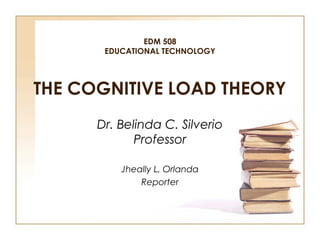
Cognitive Load Theory
- 1. EDM 508 EDUCATIONAL TECHNOLOGY THE COGNITIVE LOAD THEORY Jheally L. Orlanda Discussant
- 2. John Sweller “A theory that focuses the load on working memory during instruction.”
- 3. • is an Australian educational psychologist who is best known for formulating an influential theory of cognitive load. • He received a Ph.D. from the University of Adelaide's Department of Psychology in 1972 — his thesis was entitled "Effects of initial discrimination training on subsequent shift learning in animals and humans" — and he also received a B.A. (Hons.) from the same institution in 1969. • He has authored over 80 academic publications, mainly reporting research on cognitive factors in instructional design, with specific emphasis on the instructional implications of working memory limitations (e.g., Sweller, Merrienboer & Paas, 1998) and their consequences for instructional procedures.
- 4. Cognitive Load Theory • "Cognitive load theory has been designed to provide guidelines intended to assist in the presentation of information in a manner that encourages learner activities that optimize intellectual performance". • Employs aspects of information processing theory to emphasize the inherent limitations of concurrent working memory load on learning during instruction. • It makes use of the schema as primary unit of analysis for the design of instructional materials.
- 5. 3 Types of Cognitive Load • intrinsic cognitive load • extraneous cognitive load • germane cognitive load
- 6. OVERVIEW Clipperfield (2006) states that for a given problem or task, “I” cannot be changed. But “G” and “E” can vary and are inversely proportional to each other. The more extraneous load the less room for germane load. Thus, the duty of an instructional designer is to limit the amount of extraneous load and to build instructional presentations and activities that encourage germane load or schema formation to take place.
- 7. Intrinsic Cognitive Load • First described by Chandler and Sweller, intrinsic cognitive load is the idea that all instruction has an inherent difficulty associated with it. • This inherent difficulty may not be altered by an instructor. However many schemas may be broken into individual “subschemas” and taught in isolation, to be later brought back together and described as a combined whole.
- 8. Intrinsic Cognitive Load • Intrinsic load is the “thinking” part of cognitive learning theory. For example, if one were learning the mechanics of 2+2 for the first time, one would have to think about the combination of two items with another two items. Essentially, one would have two items, then another item (3) and then another item (4). The amount of “thinking” or “intrinsic load” affects the learning capacity. Another key component is the way in which the material is presented.
- 9. Extraneous Cognitive Load • Extraneous cognitive load, by contrast, is under the control of instructional designers. • This form of cognitive load is generated by the manner in which information is presented to learners (i.e., the design).
- 10. Extraneous Cognitive Load • To illustrate an example of extraneous cognitive load, assume there are at least two possible ways to describe a geometric shape like a triangle. An instructor could describe a triangle verbally, but to show a diagram of a triangle is much better because the learner does not have to deal with extraneous, unnecessary information.
- 11. Germane Cognitive Load • Germane load is a third kind of cognitive load which is encouraged to be promoted. • Is the load that helps building new complex schema in a successive manner in helping the learner to move from novice to expert. • It is a self effort to learn and memorized information learned. • Is coined as effective cognitive load, caused by successful schema construction.
- 12. Germane Cognitive Load • Germane load is the load used in forming new schemas. • Think back to our example of 2+2 for a moment. As an adult, we do not have to think about have two items, then adding another, then adding another. We already know that 2+2=4. • We use this knowledge to solve high level problems. For example, one could quickly tell me that 1,001,242 + 2 = 1,001,244 • These rules do not change. These are our schemas
- 13. Implications • Working memory is extremely limited. • Long term memory is essentially unlimited. • The process of learning requires working memory to be actively engaged in the comprehension (and processing) of instructional material to encode to-be-learned information into long term memory. • If the resources of working memory are exceeded then learning will be ineffective.
- 14. Classroom Implications • The goal of the instructor should be to reduce extraneous cognitive load and increase germane cognitive load. Instructors can accomplish this in a variety of ways: Change problem solving methods to avoid means-ends approaches that impose a heavy working memory load by using goal-free problems or worked examples. Physically integrate multiple sources of information whenever possible to eliminate the need for learners to have to mentally integrate that information which increases the load on working memory.
- 15. Reduce redundancy and repetitive information whenever possible so that the load on working memory is lessened. Use auditory and visual information under conditions where both sources of information are essential (i.e. non-redundant) to understanding. This helps increase the capacity of working memory.
- 16. References • http://en.wikipedia.org/wiki/Cognitive _load • http://en.wikipedia.org/wiki/John_Sw eller • http://www.learning-theories. com/cognitive-load-theory-of- multimedia-learning-sweller.html • http://www.southalabama.edu/oll/m obile/theory_workbook/cognitive_loa d_theory.htm • http://elearningindustry.com/cognitiv e-load-theory-and-instructional-design
